Chapter 16 Section 3 Contribution of Mohism to Mathematics
Mozi is a great logician.On the one hand, it uses logic to study mathematics, and at the same time it uses mathematics to study logic.Mozi's mathematical achievements include basic concepts and geometry.Now give an example:
"Jing Shang": "The body is divided into two parts."
"Sutra":
Scripture: Both are the whole, and the body is the part.
The scriptures say: The relationship between body and body is very similar to the relationship between two and one, and it is also very similar to the relationship between ruler and end.In Mozi's mathematical theory, the ruler is a geometric line, and the end is a geometric point.Therefore, if the ruler is compared to Jian, the end is just like a point.If you compare two with one, the second is combined, and the first is the body.That is, two become one, and one becomes two.The ruler is the mirror of the end, and the end is the body of the ruler.
"Jing Shang": "Ping, same height."

Figure 19
"Sutra":
This one talks about the principle of parallel lines.If AB is parallel to FG, and EK and CD are perpendicular lines of two parallel lines, then CD=EK.
"Jing Shang": "The same length, and the end of each other."
"Sutra":
This one means that the radial lines passing through the center of the circle are of the same length, just as the gate and the door frame are of the same length.Diameter AB=CD of FIG. 20 .

Figure 20
"Sutra": "Circle, one middle, same length."
"Jing Shuo Shang": "In the heart, it is the same as it is."
The heart is the center.The center of the circle is the center of the circle. "Zi Shi Xiang" means going from the center, which is the length of the radius. "Similar" means equal, with the same radius.Fig. 21 illustrates that from O to A, B are equal lengths, that is, "middle, same length". The content of "Jing Shang" and "Jing Shuo Shang" is not only the definition of a circle, but also the method of making a circle, which is simple, clear and applicable.

Figure 21
"Jing Shang": "thick, some big."
"Jing Shuo Shang": "Thick, but nothing big."
Figure 22 is a cuboid. ABCD is a plane BF is thick and also tall.Only with thickness can there be volume, so it is said: "Thickness makes it bigger.".

Figure 22
If we only talk about A, B, C, and D, it only has a plane and no thickness, so it only has an area and no volume.So it is said: "Thickness, but nothing big." "Zhuangzi · Tianxia" said: "There is no thickness that cannot be accumulated." This is the truth.
"Jing Shang": "Straight, ginseng."
"Jing Shuo Shang": None.
This one goes without saying.There are two possible explanations for it:
One is the Mohist definition of three circles and one diameter.Therefore, there should be a round character before "straight".The full text should be "circle, direct reference also".Or it can be combined with "round, one with the same length".The usage of "ginseng" in ancient China is different from three, but one third.
The second is to think that it is not Euclid's principle, which is not to use "the shortest path between two points" to explain the straight line.Instead, "three-point arrangement" is used, and the line of sight coincides with the definition of a straight line... In this explanation, the line of sight is regarded as a straight line.This is not a mathematical explanation, but a physical one.
"Sutra": "round, one middle and the same length."
"Sutra":
As shown in Figure 23, AB and CD are both diameters, and the center of the circle is O. With O as the center of the circle, a circle can be drawn.

Figure 23
"Sutra": "Four corners of square pillars [Huan Huan] also."
"Sutra":
This graph (Fig. 24) can be drawn with moments.This is "moment writing Jiaoye".But the drawn figure is not necessarily a square.

Figure 24
AB, BC, CD, DA are four pillars. ∠A, ∠B, ∠C, ∠D are right angles.This picture is the "four pillars and corners".
"Jing Shang": "Two times are two."
"Sutra":
This proposition says: Doubling is the addition of one.Two feet and one foot are nothing but two feet minus one.
"Jing Shang": "Duan, the disorder of the body and the most front."
"Jing Shuo Shang": "Duan, there is no difference."
The end is a point in geometry, the top of the line, so it is said that the end is "the disorder of the body and the first one".And because there is nothing else in front of it, it is at the forefront, so "there is no difference".Since it is "at the top", it does not participate in the order of arrangement, so it is said to be "disordered".The end should be understood as the frontmost point.
"Jing Shang": "There is a room, and the middle is also."
"Sutra":
This article shows that if there is a room, there is a middle, like a door frame, there are two rooms in between.

Figure 25
A, B, and C are each one room.A and B are the middle, and the two sides of the middle are the rooms.A is middle, AB is middle, sandwiching middle.
"Jing Shang": "The room is not as good as the side."
"Sutra":
This article means that the space does not involve the two sides, and the space is the one between the center, like a geometric line, which exists independently and is not sandwiched between points and surfaces (and, not equal).
"Jing Shang": "(纟lu), the space is empty."
Explanation 1: "Jing Shuo Shang": "(纟lu), the space between two trees is empty. Between two trees, it is said that there is no wood." Here is a seam, which is empty. (纟麦), no thick noodles.Space void, it is said that there is only length and breadth without thickness, which is the void of space.
Solution 2: is the dotted line between the two.Emptiness is the gap between two trees without wood.
"Jing Shang": "There is no such thing as surplus."
"Jing Shuo Shang": "There is no surplus and no thickness."
When the container is full, it will be full.So it is said that "there is nothing".Do it, the device is empty.When the container is empty, it will be exhausted, so it is said "No way".Thick, three-dimensional with length, width and height.There is no such thing as length, width and height.Filled, full, full of everything. "No profit" should be sought after no thick place.Those who are not thick have nothing to do with smallness.
"Jing Shang": "撄, get along with each other."
"Sutra":
撄, increase in volume.After increasing, it becomes a new volume, so it is said that "bodies and surpluses do not exhaust each other".To do is to be consistent.Lines vary in length from line to line, so it is called "endless".There is no difference between point and point, so it is called "to do".As for the point and the line, since the line is composed of points, it has an end when it comes to points, but it is not endless when it comes to lines.
"Jing Shang": "Divorce, because there is a relationship."
"Jing Shuo Shang": "Divorce, after the two have a good relationship."
Solution 1: Divorce, join, compare.Geometry secant.Intersect, that is, intersect.One body splits into two, becomes two bodies.It intersects with the secant, which is called intersecting.If the two bodies have been separated, it is non-reciprocal.It is the definition of secant to say "divorce, there are two ends and then you can do it".
Solution 2: Bi, the complicated text of Bi.To, and predicate are synonymous.From the two ends, it is to compare the length of the line segment.
撄 is bonding.There are two types of comparing the lengths of line segments: glued and unglued.Figure 26 A, line A is short and line B is long.Put line A above line B, and AB is the number that grows.This is bonding.In Fig. 26B, use a compass, take DA as the radius, and measure at line BD, so that AD and CD are both equal to the length of line A. At this time, lines A and B are not glued together.

Figure 26
Solution 3: "Jing Shang": "Like, there are some people who are related to each other, and some who are not related to each other."
"Jing Shuo Shang": "Like, if you have both ends, you can do it."
Like, should be divorced.Yes, it should be included.Like, that is, the similar shape of geometry.There are two kinds of similar shapes: similarity and non-correlation.
In Fig. 27, △AOB and AOC are similar, but also similar.All sides are foldable.But △ABC is only similar to △AOB and △AOC, but not identical, because they cannot overlap.It is relatively similar, and there must be two conditions that are equal, so it is said that "therefore the two eyes can be used".

Figure 27
∠A is a right angle. AB=AC, AO is the vertical line from A to BC, O is the center of the circle, and AO, OB, OC are the radii.
"Jing Shang": "Secondly, there is no connection without interfering with each other."
"Jing Shuo Shang": "Secondly, if there is no thickness, then you can."
Solution 1: times, that is, the so-called tangency in geometry.撄, that is, the so-called intersection in geometry.Intersecting is a secant line.When two bodies are tangent, there is no gap and no intersection between them.That's why it's said, "Secondly, there's no intermission without interfering with each other." "If you don't have any thickness, you can do it later" is also a tangent.The tangent intersects the circle with only one point of tangency.

Figure 28
Line CB is the tangent of the circle, the point of tangency is A, and A has no thickness. The BC line is seamless with the circle.
Solution 2: "Jing Shang": "If you don't hear about it, you won't be stunned."
"Jing Shuo Shang": "There is no thick but thick."
Here, 撄撄 is regarded as relative.
This is a philosophical explanation, not a geometric one.The main point is: phases are inseparable but not intertwined, only the universe meets this condition.When the universe is different, the universe is different.Omnipresent is inexhaustible.The universe is so small that it has no inside, and it is so big that it has no outside, so it is thickly approximated.Thickness and no thickness become one.
"There is thickness, there is no thickness" is a debate topic in the Warring States Period. "Xunzi · Cultivation of the Body" also said: "There is a thickness and no thickness." Therefore, there is no need to change if there is thick or not.
"Jing Shang": "Xian, (he tool), only."
"Sutra":
Solution 1: As shown in Figure 29, it is the point where the tangent line is tangent to the circle.The circle of a circle can be used as a tangent point, so it is said that "Judi" means circle.One cycle is a ring.

Figure 29
Solution 2: 焇, (he tool), and 秪 should be ring □ base.In the "Jing Shuo" (he tool) as □, Di as the people, as Di, that is, Di, the original.Shi is the same as the original meaning.As for the ring as a thing, it rotates and concentrates, and if it is mutually based, it is called "all ends".
Mozi and his successors are good at theory, rooted in practice, and emphasizing practical results.In addition to mathematics, mechanics, and optics, they also made indelible contributions to acoustics, mechanics, and civil engineering.For example, the jujube which has the function of lifting weights, the ballista which shoots huge arrows, the relay machine which throws weapons and charcoal fire, and the poplar which listens to the enemy's movement are all important inventions at that time.At present, little is known about the actual contributions of Mozi and his followers, which needs further research and exploration.
Notes:

Figure 19

Figure 20

Figure 21

Figure 22

Figure 23

Figure 24

Figure 25

Figure 26

Figure 27

Figure 28

Figure 29
Notes:
